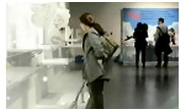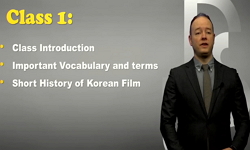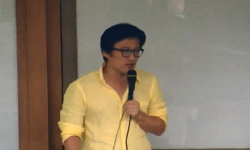Seeing Movies in Keijo and Tokyo in the 1920~1930 : Cultural History of Empire and Colonialism (Joung, Chung-sil, 2018) is about film experience of Imperial Tokyo and Colonial Keijo(京城) in the 1920s and 1930s. It is a book also that compares and...
http://chineseinput.net/에서 pinyin(병음)방식으로 중국어를 변환할 수 있습니다.
변환된 중국어를 복사하여 사용하시면 됩니다.
- 中文 을 입력하시려면 zhongwen을 입력하시고 space를누르시면됩니다.
- 北京 을 입력하시려면 beijing을 입력하시고 space를 누르시면 됩니다.

영화관의 형성과 관람의 근대 : 『경성과 도쿄에서 영화를 본다는 것-관객성 연구로 본 제국과 식민지의 문화사』에 대한 서평 = The Transition of Cinema Culture and Modern Spectatorship in Keijo(京城) and Tokyo(東京) : Book Review of Seeing Movies in Keijo and Tokyo in the 1920~1930 : Cultural History of Empire and Colonialism
한글로보기https://www.riss.kr/link?id=A105616711
- 저자
- 발행기관
- 학술지명
- 권호사항
-
발행연도
2018
-
작성언어
-
-
주제어
식민지 경성 ; 제국 도쿄 ; 영화관 ; 관객 ; 관객성 ; 유흥 ; 관람 ; 영화가 ; 映畵街 ; 유성영화 ; Colonial Keijo ; 京城 ; Imperial Tokyo ; 東京 ; Cinema ; Audience ; Spectatorship ; Entertainment ; Watching a Movie ; Cinema Zone ; Sound Film
-
KDC
800
-
등재정보
KCI등재
-
자료형태
학술저널
- 발행기관 URL
-
수록면
587-623(37쪽)
-
KCI 피인용횟수
1
- DOI식별코드
- 제공처
-
0
상세조회 -
0
다운로드
부가정보
다국어 초록 (Multilingual Abstract)
Seeing Movies in Keijo and Tokyo in the 1920~1930 : Cultural History of Empire and Colonialism (Joung, Chung-sil, 2018) is about film experience of Imperial Tokyo and Colonial Keijo(京城) in the 1920s and 1930s. It is a book also that compares and examines the spectatorship. The spectatorship mentioned in this book is conceptualized to mean the various viewers and their viewing patterns, which are dynamically determined by the movie text, screening environment, society, and cultural history. The author notes that the cinemas in Tokyo and Keijo during this period are classified as ‘playing way’ and ‘watching way’, and compares the characteristics of each viewing style. As a result, the 1930s Keijo Cinema had a longing for a sophisticated cinematic culture in the Nishi Ginza Theater in Tokyo, Japan. Since then, the film companies like Toho have been directing a large-scale movie theater in Keijo. It has resulted in favoring the excellent high-end movie theater of Namchon(南村). In the 1930s, the ethnic boundaries of movie theaters collapsed and the hierarchical relationship between the movie theaters was weakened. And then the entertainment industry in Keijo was changed. To the end, it is regrettable that the screening program, the film format and genre enjoyed, and the standardization of Hollywood viewing culture are missing.
참고문헌 (Reference)
1 유선영, "황색식민지의 서양영화 관람과 소비실천, 1934-1942:제국에 대한 '문화적 부인'의 실천성과 정상화 과정" 사단법인 언론과 사회 13 (13): 7-62, 2005
2 키타다 아키히로, "확장하는 모더니티" 소명출판 2007
3 안종화, "한국영화측면비사" 현대미학사 1998
4 김소영, "파국의 지도" 현실문화 2014
5 한상언, "조선영화의 탄생" 박이정 2018
6 백문임, "조선영화란 何오" 창작과비평 2016
7 이화진, "조선 영화-소리의 도입에서 친일 영화까지" 책세상 2005
8 김순주, "제국의 ‘소리들’과 식민지 ‘이중 도시’의 변화: 1930년대 전반기 경성의 발성영화 상영과 상영 현장의 변화" 서울학연구소 (62) : 27-57, 2016
9 박선영, "잡후린(囃侯麟)과 애활가(愛活家)-조선극장가의 찰리 채플린 수용과 그 의미: 1920-30년대 경성 조선인 극장을 중심으로" 대중서사학회 (30) : 149-183, 2013
10 사토오 다다오, "일본영화 이야기" 다보문화 1993
1 유선영, "황색식민지의 서양영화 관람과 소비실천, 1934-1942:제국에 대한 '문화적 부인'의 실천성과 정상화 과정" 사단법인 언론과 사회 13 (13): 7-62, 2005
2 키타다 아키히로, "확장하는 모더니티" 소명출판 2007
3 안종화, "한국영화측면비사" 현대미학사 1998
4 김소영, "파국의 지도" 현실문화 2014
5 한상언, "조선영화의 탄생" 박이정 2018
6 백문임, "조선영화란 何오" 창작과비평 2016
7 이화진, "조선 영화-소리의 도입에서 친일 영화까지" 책세상 2005
8 김순주, "제국의 ‘소리들’과 식민지 ‘이중 도시’의 변화: 1930년대 전반기 경성의 발성영화 상영과 상영 현장의 변화" 서울학연구소 (62) : 27-57, 2016
9 박선영, "잡후린(囃侯麟)과 애활가(愛活家)-조선극장가의 찰리 채플린 수용과 그 의미: 1920-30년대 경성 조선인 극장을 중심으로" 대중서사학회 (30) : 149-183, 2013
10 사토오 다다오, "일본영화 이야기" 다보문화 1993
11 고마츠 히로시, "옥스퍼드 세계영화사" 열린책들 2006
12 미리엄 실버버그, "에로틱 그로테스크 넌센스–근대 일본의 대중문화" 현실문화 2014
13 김소영, "신여성의 시각적 재현" 문학과영상학회 7 (7): 93-130, 2006
14 백문임, "식민지 극장의 무성 영화 관람성(audienceship) - 청각장(場)의 문제를 중심으로" 한국언어문화학회 (38) : 43-68, 2009
15 이화진, "소리의 정치-식민지 조선의 극장과 제국의 관객" 현실문화 2016
16 주창규, "버나큘러 모더니즘의 스타로서 무성영화 변사의 변형에 대한 연구" 한국영화학회 (32) : 257-288, 2007
17 조희문, "무성영화의 해설자 변사 연구" 한국영화학회 13 : 1997
18 우수진, "무성영화 변사의 공연성과 대중연예의 형성" 한국극예술학회 (28) : 43-69, 2008
19 정충실, "경성과 도쿄에서 영화를 본다는 것-관객성 연구로 본 제국과 식민지의 문화사" 현실문화 2018
20 "京城日報"
21 한국영상자료원 영화사연구소, "『일본어 잡지로 본 조선영화』 1" 한국영상자료원(KOFA) 2010
22 노지승, "‘나운규 영화’의 관객들 혹은 무성 영화 관객에 대한 한 연구-식민지 시기, 관객의 변화와 나운규 영화의 의미" 상허학회 23 : 116-139, 2008
23 Ben M. Hall, "The Best Remaining Seats : The Story of the Golden Age of the Movie Palace" Clarkson N. Potter 1961
24 Miriam Hansen, "Early Cinema : Space, Frame, Narrative" British Film Institude 1990
25 주훈, "1920-30년대 한국의 영화 관객성 연구 : 무성영화 관객을 중심으로" 서울대학교 대학원 2005
동일학술지(권/호) 다른 논문
-
- 국제비교한국학회
- 노가미다츠히코
- 2018
- KCI등재
-
- 국제비교한국학회
- 야나기하라야스코
- 2018
- KCI등재
-
- 국제비교한국학회
- 심원섭
- 2018
- KCI등재
-
- 국제비교한국학회
- 정명교 ( Jeong Myeong-kyo )
- 2018
- KCI등재
분석정보
인용정보 인용지수 설명보기
학술지 이력
| 연월일 | 이력구분 | 이력상세 | 등재구분 |
|---|---|---|---|
| 2022 | 평가예정 | 재인증평가 신청대상 (재인증) | |
| 2019-01-01 | 평가 | 등재학술지 유지 (계속평가) |  |
| 2016-01-01 | 평가 | 등재학술지 선정 (계속평가) |  |
| 2015-12-01 | 평가 | 등재후보로 하락 (기타) |  |
| 2015-11-09 | 학술지명변경 | 한글명 : Comparative Korean Studies -> 비교한국학 Comparative Korean Studies |  |
| 2011-01-01 | 평가 | 등재학술지 유지 (등재유지) |  |
| 2009-01-01 | 평가 | 등재 1차 FAIL (등재유지) |  |
| 2006-01-01 | 평가 | 등재학술지 선정 (등재후보2차) |  |
| 2005-01-01 | 평가 | 등재후보 1차 PASS (등재후보1차) |  |
| 2004-01-01 | 평가 | 등재후보학술지 유지 (등재후보2차) |  |
| 2003-01-01 | 평가 | 등재후보 1차 PASS (등재후보1차) |  |
| 2002-01-01 | 평가 | 등재후보학술지 유지 (등재후보1차) |  |
| 2001-01-01 | 평가 | 등재후보학술지 선정 (신규평가) |  |
학술지 인용정보
| 기준연도 | WOS-KCI 통합IF(2년) | KCIF(2년) | KCIF(3년) |
|---|---|---|---|
| 2016 | 0.49 | 0.49 | 0.42 |
| KCIF(4년) | KCIF(5년) | 중심성지수(3년) | 즉시성지수 |
| 0.46 | 0.49 | 0.818 | 0.06 |




 KISS
KISS






